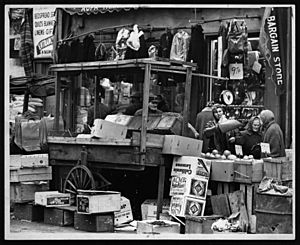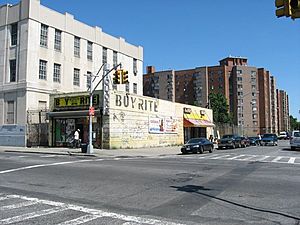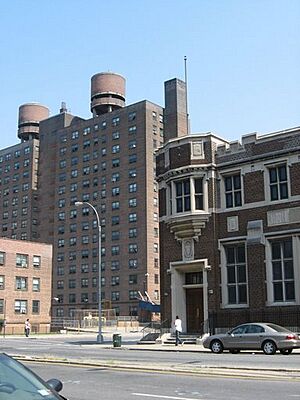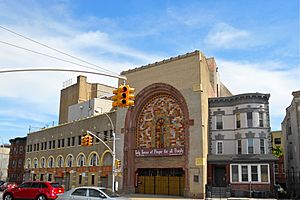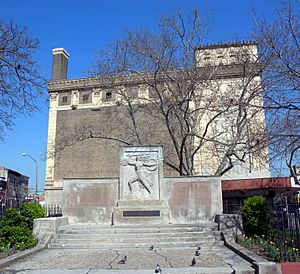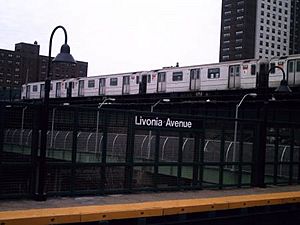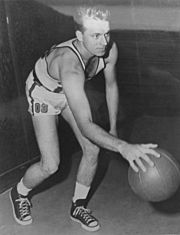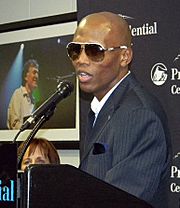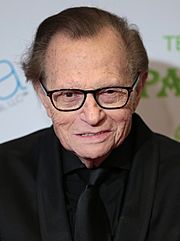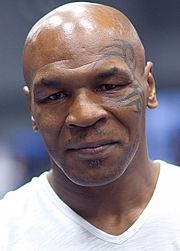Brownsville, Brooklyn facts for kids
Quick facts for kids
Brownsville
|
|
|---|---|
|
Neighborhood of Brooklyn
|
|

The Samuel J. Tilden Houses, one of many NYCHA public housing developments located in Brownsville
|
|
| Country | |
| State | |
| City | New York City |
| Borough | Brooklyn |
| Community District | Brooklyn 16 |
| Parceled | 1858 |
| European settlement | 1861 |
| Founded by | William Suydam |
| Named for | Charles S. Brown |
| Area | |
| • Total | 3.01 km2 (1.163 sq mi) |
| Population | |
| • Total | 58,300 |
| • Density | 19,355/km2 (50,130/sq mi) |
| Economics | |
| • Median income | $31,252 |
| Ethnicity | |
| • White | 3.8% |
| • African American | 68.4% |
| • Hispanic American | 25.6% |
| • Asian/Pacific Islander | 0.9% |
| • Other | 1.3% |
| Time zone | UTC−5 (Eastern) |
| • Summer (DST) | UTC−4 (EDT) |
| ZIP Codes |
11212, 11233
|
| Area codes | 718, 347, 929, and 917 |
Brownsville is a neighborhood located in eastern Brooklyn, New York City. It is mainly a residential area. Brownsville is surrounded by other Brooklyn neighborhoods like Crown Heights to the northwest, Bedford–Stuyvesant and Cypress Hills to the north, and East New York to the east.
The neighborhood covers about 1.163 square miles (3.01 km2) and had 58,300 residents in 2010. Brownsville started in its current form in 1858. It was first settled by Jewish factory workers. In the 1950s, many African-American residents moved into the area. Since the late 1900s, Brownsville has faced challenges with poverty compared to other parts of New York City.
Brownsville is part of Brooklyn Community District 16. Its main ZIP Code is 11212. The New York City Police Department's 73rd Precinct patrols the area. Local politicians from the New York City Council's 42nd and 41st Districts represent Brownsville.
Contents
Brownsville's Past: A Look at Its History
How Brownsville Started
The land that became Brownsville was first used by the Dutch for farming. They also made building materials there. In the 1820s, the Dutch built the New Lots Reformed Church nearby. This church, with its cemetery from 1841, is now a historic site.
In 1858, a man named William Suydam divided the land into many small plots. He built simple homes for workers. However, Suydam ran out of money because the area was not very popular. In 1861, the land was sold to Charles S. Brown. He divided the land again and named it "Brownsville." He encouraged Jewish people from Lower Manhattan to move there, highlighting the open spaces. By 1883, "Brown's Village" had 250 houses, mostly for factory workers who traveled to Manhattan.
In the 1880s, Brownsville was a marshy area. It was sometimes used as a dumping ground. Smells from glue factories near Jamaica Bay often drifted into the neighborhood. The area was too far from Manhattan for wealthy people to want to live there. But the land was cheap enough for developers to build many homes for poorer families.
Brownsville as a Jewish Neighborhood
From the 1880s to the 1950s, Brownsville was mostly a Jewish neighborhood. In 1887, a businessman named Elias Kaplan showed the first Jewish residents around. He said Brownsville was better than the Lower East Side because it was easier to avoid strong labor unions. Kaplan built a factory and homes for his workers. He even put a synagogue called Ohev Sholom inside his factory.
Other factories that made things like food, furniture, and metal products soon followed. This led to many more homes being built in Brownsville. The area quickly became very crowded with factories, shops, and homes close together.
By 1900, about 25,000 people lived in Brownsville. Most lived in two-story wooden houses meant for two families. But many of these homes were extremely crowded, with up to eight families living in one house. Many homes did not have running water. Their wooden structure also made them likely to catch fire. Newer brick-and-stone houses built in the early 1900s had indoor plumbing and were safer from fires.
The quality of life was also affected because the unpaved roads were used as open sewers. Land prices in Brownsville were high. So, developers built as many apartments as possible on each lot to make their money back. Within 20 years, the area became known for its crowded conditions. By 1907, 24 out of 25 housing units in Brownsville were tenement buildings. It became as crowded as the Lower East Side. There were also no playgrounds, and the only park was Betsy Head Park.
In the early 1900s, most Brownsville residents were born outside the United States. In 1910, 66% were first-generation immigrants. About 80% of these immigrants were from Russia. By 1920, over 80,000 of the 100,000 residents were Russian Jews. Brownsville was even called "Little Jerusalem." By the 1930s, it was the most crowded area in all of Brooklyn. The neighborhood remained very Jewish, with about 70 Orthodox synagogues. Many of these old synagogues are now churches.
Brownsville was also a center for new political ideas. In the 1920s and 1930s, the neighborhood elected Socialist and American Labor Party politicians. These Socialist ideas were popular until World War II.
The area was quite successful during its best years. In 1942, Pitkin Avenue had 372 stores, including 8 banks. These businesses employed about 1,000 people and made an estimated $90 million each year. The average income in 1933 was $2,493, which was twice that of a family in the Lower East Side. The Fortunoff's furniture store chain started on Livonia Avenue.
Changes in the Late 20th Century
From the 1940s to the 1960s, Brownsville's population changed. More African-American and Latino people moved in. In 1940, black residents were 6% of the population. By 1950, that number had doubled. Most of these new residents were poor and lived in the least desirable housing.
The city, led by urban planner Robert Moses, replaced some of Brownsville's old tenement buildings with public housing complexes. Even though the neighborhood was becoming racially separate, there were efforts to improve life and create friendship between black and Jewish residents. However, due to economic differences, many of these improvements did not last.
By the 1960s, most of Brownsville's population was African American. The unemployment rate was 17%, which was twice the rate for New York City as a whole. By 1970, Brownsville had 130,000 residents. About 77% were black and 19% were Puerto Rican.
Brownsville's Geography and Buildings
Brownsville covers about 1.163 square miles (3.01 km2). The main ZIP codes are 11212 and 11233. Brownsville is bordered by Broadway or Atlantic Avenue to the north. It is next to Bedford–Stuyvesant and Bushwick. To the northwest is East New York Avenue, bordering Ocean Hill–Broadway Junction. To the west are East 98th Street and Ralph Avenue, bordering Flatbush, Weeksville, and Crown Heights.
To the south, the Bay Ridge Branch of the Long Island Rail Road and Linden Boulevard border Canarsie. To the east, Van Sinderen Avenue is next to East New York. Brownsville is part of Brooklyn Community Board 16, which also includes Ocean Hill–Broadway Junction.
Homes and Buildings
In 2008, Brownsville had 28,298 housing units. The neighborhood has many public housing developments. These are mostly in a small area between Powell Street, Rockaway, Livonia, and Sutter Avenues. This area has the highest number of public housing buildings in New York City. It is also the most crowded area of public housing in the United States.
The New York City Housing Authority (NYCHA) owns about one-third of Brownsville's housing. This includes about 10,000 units in 18 developments, with over 100 buildings. These housing developments alone are home to almost 21,000 people. Some of these developments include:
- Brownsville Houses (27 buildings)
- Howard Houses (10 buildings)
- Tilden Houses (8 buildings)
- Van Dyke I (22 buildings)
South of Pitkin Avenue, there are also many row houses that are similar to those in East New York. Many of these have been replaced by new, subsidized rowhouses with gardens and driveways. Most of these new homes were built under the Nehemiah development program.
The Livonia Avenue Initiative is a project to build 791 apartments or houses for low-income residents. This includes Livonia Commons, a mixed-use project with 270 apartments and shops. It will also have community spaces, including a senior center and school classrooms. There will also be a gym, a swimming pool, and studios.
Closer to Ocean Hill, there are many limestone and brownstone townhouses. Some older tenement buildings are also still in the area. About 73% of rental housing in Brownsville is not well maintained. This is higher than the average for Brooklyn and New York City.
Interesting Places to Visit
The Loews Pitkin was a grand movie theater built in 1929. It was 85 feet high and had 2,827 seats. It was one of 22 theaters in the area, but most others were torn down or became stores. The Loews Pitkin was not used much by the 1970s. Its old inside was used as a church and a furniture store. In 2008, Poko Partners bought the building. They spent $43 million to turn it into a charter school and shops. The school opened in 2012, along with 60,000 square feet (5,600 m2) of retail space.
Many empty lots in Brownsville are now community gardens. These gardens are also common in nearby East New York. Community groups take care of them. They often grow vegetables for residents. These gardens were meant to be temporary. But they became so popular that in 2015, New York City stopped plans to build on 34 garden sites in Brownsville.
The old NYPD 65th Precinct building at 1546 East New York Avenue was built in 1901. It was closed in the mid-1980s. In 2004, a non-profit group bought the building. They planned to turn it into a community center. But the building is still empty and covered in graffiti.
One block of Livonia Avenue is called "African Burial Ground Square." This is to remember an African burial ground found there in 2010. The site has remains similar to those found in other parts of New York City. The Schenck Playground, behind the Brooklyn Public Library, will be redesigned with African cultural themes.
Hyman Spitz Florists was one of the first businesses in Brownsville, founded in 1898. It stayed at the same address until 2004. Hyman Spitz Florists even provided flowers for famous events, like Donald and Ivana Trump's wedding.
Brownsville's People
Based on the 2010 United States Census, Brownsville had 58,300 people. This was a small decrease from 59,099 people in 2000. The neighborhood covers about 750.44 acres (303.69 ha).
The people living in Brownsville in 2010 were:
- 76.1% African American
- 0.8% White
- 0.3% Native American
- 0.7% Asian
- 0.0% Pacific Islander
- 0.3% from other races
- 1.2% from two or more races
- 20.6% were Hispanic or Latino (of any race).
About 29.9% of the people had graduated from high school. Only 8.4% had a bachelor's degree or higher.
In 2018, the average life expectancy in Brownsville was 75.1 years. This is lower than the average of 81.2 years for all New York City neighborhoods. Most residents are middle-aged adults and young people. About 28% are under 18, 27% are between 25 and 44, and 23% are between 45 and 64.
In 2016, the average household income in Brownsville was $30,207. In 2018, about 28% of Brownsville residents lived in poverty. This is higher than the 21% for Brooklyn and 20% for New York City. One in seven residents (14%) were unemployed. This is higher than the 9% for Brooklyn and New York City. About 57% of residents have trouble paying their rent. This is also higher than the city and borough averages.
Fire Protection
The firehouse for the New York City Fire Department (FDNY)'s Engine Co. 231/Ladder Co. 120 is in Brownsville.
A new, 21,000-square-foot (2,000 m2), $32 million FDNY building is being built at 815 Sterling Place. This new facility will be an FDNY training center and the firehouse for Rescue Company 2. Construction started in July 2016. It will replace Rescue 2's old, smaller building in Crown Heights.
Parks and Fun Places
Parks in Brownsville
Just east of the Crown Heights–Utica Avenue subway station, there is a park called Lincoln Terrace. It slopes down towards the southern Brooklyn coast. The city bought the 21 acres (8.5 ha) of land for this park between 1895 and 1897. The park was named after Abraham Lincoln. In 1932, the western part was renamed after Arthur S. Somers, a local activist. The park and its playgrounds were also updated around that time.
Betsy Head Park is on Livonia Avenue. Betsy Head, a wealthy British woman, left $190,000 in her will for "recreational facilities" when she died in 1907. When the park opened in 1914, it was the only one in the neighborhood and was very crowded. It was praised for its "rest pavilion, wading pool, playground, school farm garden, bath building, swimming pool, field house, running track, and tennis courts." In 1936, a new Olympic-size swimming pool was added as part of a Works Progress Administration project.
The park was renovated in 1983 for $5.2 million. A new running track was added in 2001. In 2008, the New York City Landmarks Preservation Commission made the Betsy Head Play Center a landmark. In early 2016, the playground inside the park was renovated for $5.05 million. It now has an "Imagination Playground" with movable foam play blocks.
At Livonia Avenue and Powell Street, Livonia Park is named after Livonia, a region in the Baltic area (now Latvia and Estonia). The park has trees, benches, gaming spaces, and grassy areas. The red-and-white bricks in Livonia Park are the colors of the Latvian flag.
Fun Activities
Brownsville has its own recreation center with indoor swimming pools, outdoor sports fields, and a playground. This is the Brownsville Recreation Center, located at Linden Boulevard, Mother Gaston Boulevard, and Christopher Avenue. Like other city pools, you need a NYC Parks pool membership to use the indoor pools. It opened in 1953 as the Brownsville Boys' Club. The center was improved in the late 1990s and 2000s, including new playgrounds and updated facilities.
The "Soul in the Hole" is a famous basketball court in Brownsville. It is known for its tough street basketball games. It is located in the Brownsville Houses along Rockaway Avenue. Famous players like Fly Williams have played there.
Other Open Spaces
The traffic triangle at Pitkin and East New York Avenues and Legion Street was first named Vanderveer Park. In 1911, it was renamed Zion Park to honor the Jewish community. The Zion Park War Memorial, a large stone wall, was put there in 1925. This monument has a star of David.
The Wyckoff Triangle is named after Hendrick Wyckoff, who owned land there. He was a spy for the colonists during the American Revolutionary War. This park is now privately maintained because it is too small to be a public NYC Parks space.
Zion Triangle Memorial
The Zion Triangle is a memorial stone structure. It honors neighborhood residents who fought and died for the country in wars. When it was first built, Brownsville was an all-Jewish neighborhood. That is why it is named Zion Triangle and includes the Jewish Star Symbol, which is still on the stone today. In the 1970s and 80s, the structure was badly vandalized. It was cleaned up and restored by the 1990s. In 2016, a Jewish American veteran named Howard Radish, who was a prisoner of war in Germany, was honored at this location. He had grown up in Brownsville when it was a Jewish neighborhood.
Getting Around Brownsville
Public Transportation
Brownsville has good public transportation. The New York City Subway serves Brownsville with the IRT New Lots Line (2, 3, 4, and 5 train) and the BMT Canarsie Line (L train). The New Lots Line stations from Saratoga Avenue to Junius Street are in Brownsville.
There is a pedestrian bridge from the Livonia Avenue station on the Canarsie Line to Junius Street. From there, an entrance to the Junius Street station on the New Lots Line is very close. There are plans to make this bridge a free transfer point between the two subway lines. This would help with more riders and new housing in the area.
MTA Regional Bus Operations also runs bus lines in Brownsville. The B15 bus goes across Brownsville, mostly on New Lots Avenue. The B14 bus uses Pitkin and Sutter Avenues. North-south bus lines include the B7 on Saratoga Avenue and the B60 on Rockaway Avenue.
In 2011, 72% of residents used public transportation. This was up from 66% in 2000. More than 85% of residents live within 0.5 miles (0.80 km) of a subway station.
Brownsville Streets
The streets in Brownsville mostly run north-south. Some streets from Canarsie also extend into Brownsville. East 98th Street is the end point for many main roads in central Brooklyn.
Because of its Jewish history, some streets in western Brownsville are named after Jewish community figures. In 1913, Ames Street was renamed Herzl Street after writer Theodor Herzl. This is one of the few streets outside Israel named Herzl Street. Strauss Street, nearby, is named after brothers Nathan and Isidor Straus, who were co-owners of Macy's. Isidor Straus died when his wife Ida gave up her seat on a lifeboat during the sinking of the RMS Titanic.
One of Brownsville's main roads, Pitkin Avenue, is named after businessman John R. Pitkin. He started developing East New York in 1835.
Hopkinson Street was renamed in honor of State Assemblyman Thomas S. Boyland. He served the neighborhood from 1977 until his death in 1982. Many places in Brownsville, including schools and housing, are named after Boyland and his family members who were also involved in politics.
Stone Avenue was renamed after Rosetta Gaston (1895–1981). She founded the Brownsville Heritage House on the avenue. Mother Gaston, as she was called, ran the Heritage House inside the Stone Avenue Library. This library was built in 1914.
Brownsville in Books and Movies
The 1934 novel Call It Sleep by Henry Roth is about the Schearl family. They move from Brownsville back to the Lower East Side. The book describes Brownsville as a much better place than the Lower East Side.
Alfred Kazin wrote about Brownsville in the 1920s in his memoir A Walker in the City.
Learning in Brownsville
Brownsville schools have high dropout rates. Students also often score low on state tests, with 95% scoring below their grade level.
Brownsville generally has fewer college-educated residents than the rest of New York City. In 2018, 21% of residents had a college education or higher. However, 27% had less than a high school education. The percentage of Brownsville students doing well in reading and math has been increasing. Reading achievement went from 26% in 2000 to 31% in 2011. Math achievement went from 20% to 38% in the same time.
Brownsville has the second-highest rate of student homelessness in Brooklyn. It also has the highest rate of elementary school student absences in New York City. About 39% of elementary students miss 20 or more days of school each year. Also, only 65% of high school students in Brownsville graduate on time. This is less than the city average of 75%.
Schools in Brownsville
Public schools are run by the New York City Department of Education. Because Brownsville is very crowded, there are 39 public and charter schools for elementary and middle school students. Some of these include P.S. 150 Christopher, P.S. 156 Waverly, and P.S. 184 Newport.
There are three high schools in Brownsville. Two are in the same building at 226 Bristol Street. Teachers Preparatory opened in 2001. Frederick Douglass Academy VII opened in 2004. Teachers Preparatory School serves students from 6th to 12th grade. Frederick Douglass Academy VII serves 9th to 12th grade. Both schools have almost all minority students. The third high school is Brownsville Academy. It is a smaller school for 10th to 12th graders. It is located at 1150 East New York Avenue.
Libraries in Brownsville
The Brooklyn Public Library (BPL) has two branches in Brownsville. The Brownsville branch is at 61 Glenmore Avenue. It opened in 1905. The current 10,550-square-foot (980 m2) branch opened in 1908.
The Stone Avenue branch is at 581 Mother Gaston Boulevard. When it opened in 1914 as the Brownsville Children's Library, it was one of the world's first children's libraries. It was also one of the last Carnegie libraries in Brooklyn. The branch was renovated in 2014.
Famous People from Brownsville
Many notable people have come from Brownsville, including:
- Masta Ace (born 1966), rapper
- Lyle Alzado (1949–1992), NFL defensive tackle
- Maurice Ashley (born 1966), chess grandmaster
- Eric Adams (born 1960), current mayor of New York City
- Ralph Bakshi (born 1938), film director
- Riddick Bowe (born 1967), boxer
- Shannon Briggs (born 1971), boxer
- Andrew Dice Clay (born 1957), comedian
- Aaron Copland (1900–1990), composer
- Vince Edwards (1928–1996), actor
- Fyvush Finkel (1922–2016), actor
- Max Fleischer (1883–1972), animator
- Brian Flores (born 1982), NFL coach
- John Forté (born 1975), rapper
- World B. Free (born 1953), former NBA player
- Nelson George (born 1957), author
- Marty Glickman (1917–2001), sportscaster
- Sid Gordon (1917–1975), 2x All Star baseball player
- Arnold Greenberg (1932–2012), co-founder of Snapple
- Red Holzman (1920–1998), NBA Hall of Fame player and coach
- Moe (1897–1975), Curly (1903–1952), and Shemp Howard (1895–1955), members of The Three Stooges
- Thirstin Howl the 3rd, rapper
- Daniel Jacobs (born 1987), boxer
- Zab Judah (born 1977), boxer
- KA (born 1972), rapper
- Donald Kagan (1932–2021), historian
- Danny Kaye (1911–1987), entertainer
- Alfred Kazin (1915–1998), writer and literary critic
- Larry King (1933–2021), television and radio host
- Alvin Klein (c. 1938 – 2009), theater critic
- Steve Lawrence (born 1935), singer
- Leonard Marsh (1933–2013), co-founder of Snapple
- Zero Mostel (1915–1977), actor
- M.O.P., hip hop duo
- Eddie Mustafa Muhammad (born 1952), former boxer
- Alex B. Novikoff (1913–1987), cell biologist
- O.G.C., hip hop group
- Joseph Papp (1921–1991), theatrical producer/director
- Norman Podhoretz, writer
- Sean Price (1972–2015), rapper
- Killah Priest, rapper
- Isidor Isaac Rabi (1898–1988), physicist and Nobel Prize winner
- Paul Rand, graphic designer
- Willie Randolph, former baseball player, manager, and coach
- Representativz, hip hop duo
- RZA, rapper, member of the Wu-Tang Clan
- Meyer Schapiro, art historian
- Phil Sellers, former NBA player
- Al Sharpton, minister
- Allie Sherman (1923–2015), NFL player and head coach
- Phil Silvers, comic
- Heltah Skeltah, hip hop group
- Jimmy Smits, actor
- Bern Nadette Stanis, actress
- Smif-N-Wessun, hip hop duo
- Sparky D (1965), MC & rapper
- Sid Tannenbaum (1925–1986), professional basketball player
- Herb Turetzky (1945–2022), official scorer for the Brooklyn Nets
- Mike Tyson (born 1966), boxer
- Dwayne "Pearl" Washington (1964–2016), professional basketball player
- Allen Weisselberg (born 1947), businessman
- Fly Williams (born 1953), former NBA player
- Nicole Willis (born 1963), singer-songwriter
- Otis Wilson (born 1957), former NFL linebacker
- Terry Winters (born 1949), artist
- Max Zaslofsky (1925–1985), professional basketball player and coach
- Howard Zinn (1922–2010), historian
Images for kids
See also
 In Spanish: Brownsville, Brooklyn para niños
In Spanish: Brownsville, Brooklyn para niños


